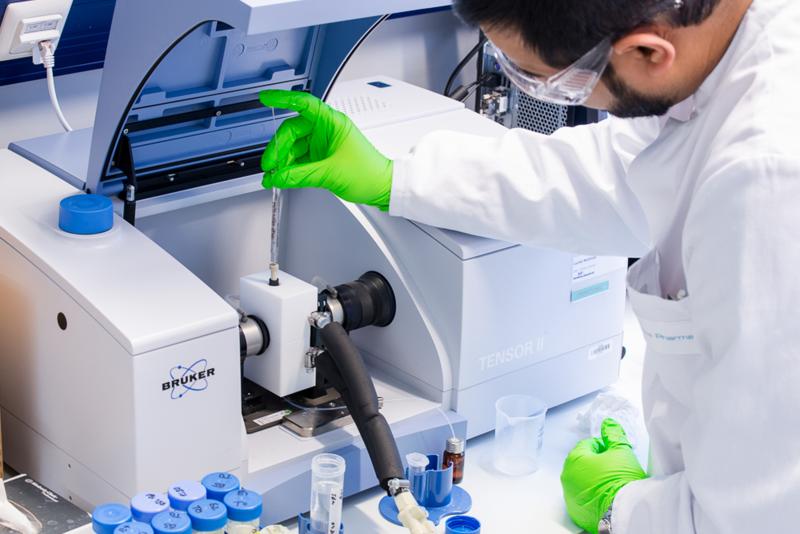Fourier transform infrared (FTIR) spectroscopy
Fourier transform infrared (FTIR) spectroscopy is a highly valuable technique to monitor protein structure in the liquid and dried, e.g., lyophilized state.

FTIR spectra can be used to identify a wide range of compounds by comparing the measured spectra to spectral databases. For proteins, FTIR spectra from wavenumbers 1,700-1,500 cm-1 can be used to determine structural properties. Measuring protein absorbance over these wavenumbers gives two absorption bands, conventionally called Amide I and Amide II and lying between wavenumbers 1,700 - 1,600 cm-1 and 1,600 - 1,500 cm-1, respectively.
The Amide I band is due to C=O stretching vibrations of the peptide bonds, which are modulated by the secondary structure (α-helix, β-sheet, etc.). Secondary structural content can be obtained by comparing the measured spectra to the spectra obtained for proteins with known secondary structures.
The Amide II band is due to C-N stretching vibrations in combination with N-H bending. Amide II absorbance can be used, for instance, to report on protein unfolding based on the extent of hydrogen (H) exchanged for deuterium (D) in H-D exchange experiments.
Water can interfere with FTIR measurements of protein samples, because it strongly absorbs in the Amide I region. Consequently, FTIR is best suited for lyophilized (freeze-dried) protein samples. Nevertheless, measurements can be obtained for protein samples in solution, but a relatively high (typically >5 mg/mL) protein concentration is required. Both liquid (transmission, attenuated total reflection (ATR)) and solid (ATR) samples can be analyzed at Coriolis Pharma.
Quality & biosafety level of this method
We provide all our analytical services with the highest quality standards. Each project is carried out by experienced scientists and every report or data presentation is comprehensively checked by a scientific reviewer. We offer this technology with the following quality and biosafety level:
Standardized methods or dedicated method development
For common sample types, we can often apply standardized methods with little setup effort. On top of this, our experienced analytical scientists perform in-depth method development or method optimization tailored to your drug substance, product type and development phase.
Method development
During method development, we tailor sample preparation, method settings, and data analysis to the needs of your project and sample.
For this purpose, we include a representative sample and, where available, suitable reference standards and stressed/degraded materials. This way, our analytical scientists can design a method that is highly suitable for your needs, stability indicating, as well as robust and repeatable. Upon request, we compile a detailed method description for your records.
This can be applied under R&D. Read more
Method qualification
A method qualification is the initial assessment of the performance of an analytical procedure to show that it is suitable for the intended purpose.
During method qualification, our analytical scientists perform a documented testing that demonstrates that the analytical procedure meets certain acceptance criteria in several categories. These may include repeatability, linearity, intermediate precision, robustness and more. We compile a qualification plan and a qualification report including all relevant data.
This can be applied under R&D. Read more
Contact us
Contact us
Do you have any questions? Want to analyze your samples?


